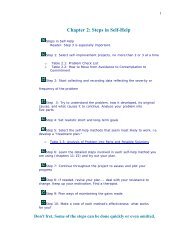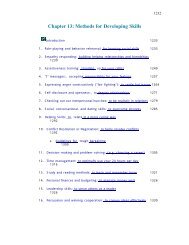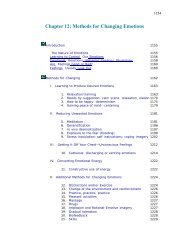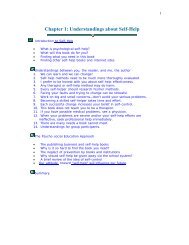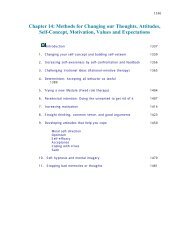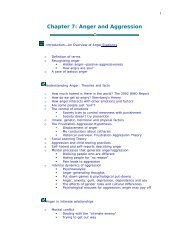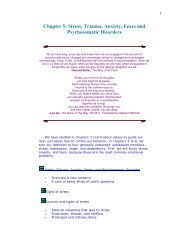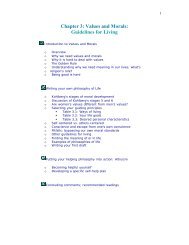Methods for Changing Behaviors - Psychological Self-Help
Methods for Changing Behaviors - Psychological Self-Help
Methods for Changing Behaviors - Psychological Self-Help
You also want an ePaper? Increase the reach of your titles
YUMPU automatically turns print PDFs into web optimized ePapers that Google loves.
Challenge defeatist attitudes; let your body and mind work<br />
automatically without constant criticism and coaching; get into the<br />
“flow”<br />
Seeing ourselves as helpless or as bungling has dramatic effects-we<br />
per<strong>for</strong>m poorly, we stop trying, and we get depressed (Seligman,<br />
1975). Some people respond to an actual failure by "falling apart;"<br />
others try harder. What determines the difference? One simple factor<br />
is how the per<strong>for</strong>mer explains the failure: if you say, "It's my fault, I<br />
can't do it," you do more poorly next time and give up. If you say, "I<br />
need to try harder, maybe I can do it," you'll do better after failure.<br />
The really good news is that people can learn to interpret failure as a<br />
sign they need to work harder (not a lack of ability), can draw from<br />
their experience to learn a better approach, and can develop their own<br />
self-instructions to achieve success (Diener & Dweck, 1978).<br />
A related idea is that a restful, noncritical state of mind is the most<br />
efficient. Thus, teachers try to relax students and coaches try to calm<br />
players. Gallwey (1974) in The Inner Game of Tennis describes how<br />
we have two identities: one is playing tennis (or whatever we are<br />
doing), the other is telling ourselves how to do it! It certainly seems<br />
that way. The goal of this method is to quiet the critical coach that<br />
confuses things with a stream of instructions and upsets things with<br />
accusations, doubts and fears.<br />
Gallwey's concept of per<strong>for</strong>ming uncritically is close to<br />
Csikszentmihalyi's (1990) notion of "flow." Sometimes you "get in the<br />
groove" and everything goes just right. You are calm and<br />
concentrating intensely on the task; things just click and you are really<br />
enjoying doing a super job. When this happens you are totally<br />
absorbed in the work. That's flow.<br />
This method is not concerned with all aspects of low self-regard<br />
(see chapters 6 and 14) but rather (1) with detecting the barriers that<br />
keep you from trying and doing your best, (2) with reducing the inner<br />
voices of criticism and helplessness that disrupt your ef<strong>for</strong>ts, and (3)<br />
with finding ways to reach your maximum efficiency.<br />
Purposes<br />
Steps<br />
· To recognize a lack of confidence and do something about it.<br />
· To reduce the inner critic so one can do one's best.<br />
· To achieve maximum efficiency and interest in a task.<br />
STEP ONE: Become aware of self-doubts.<br />
1113



